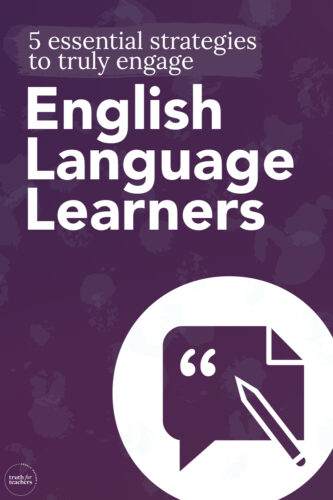
16 Mar 5 essential strategies to truly engage English Language Learners
If you have English Language Learners (ELLs) in your classroom and are wondering how to best support them, you’re in the right place!
You can help better keep ELLs engaged in classroom conversations when you prepare them with these simple scaffolds.
This doesn’t take a lot of planning but it takes the initial step to analyze your teaching and where you can incorporate these ideas!

You might surprise yourself and realize that you are already doing some of these things. Often, the tried-and-true strategies are the best, and by focusing on doing just a few core things consistently and well, you can see great results.
1. Communicate with your ESL/ESOL teacher
Who to help support you other than your ESL teacher? When classroom teachers and I are communicating with one another, it helps us both understand how we can support ELLs in and out of the classroom.
Collaborating can be at varied levels and comfort between one another. It can be as simple as sharing lesson plans or units to scaffold and share resources with one another. Or, try weekly discussions about ELLs progress and needs.
Some collaborations reach levels of co-teaching lessons together. As long as there is an open communication and inclusion of the ESL teacher, this benefits our ELLs.
2. Make it visual
Pictures are remembered better than words. When you are giving instructions without any form of visual or modeling, ELLs are trying to process the spoken language. But when you include a visual to go with directions or with specific content vocabulary, they are more likely to make a word connection in their own language vocabulary.
This will also help you figure out what your students know or don’t know already. With technology nowadays, you can find appropriate pictures or videos to incorporate within your lessons or put pictures up around your classroom.
3. Use wait time
As ELLs are processing all the information, questions, or directions you have just given, provide wait time. We think that if students know something, they should respond right away. So we typically only give 3-5 seconds and expect students to have the correct response immediately.
ELLs are not only processing what was said, they are trying to internalize the new information and produce new language to show what they know. Not having the extra wait time sometimes discourages ELLs to think about the answer or feel the need not to answer at all.
So next time, wait 10-15 seconds longer; it might feel awkward at first but see if you notice a difference in participation.
4. Sentence frames
Sentence frames are meant to encourage academic, content, and technical language use. This is not part of our everyday spoken English vocabulary.
When providing a sentence frame or starter, it is NOT giving them the “answers” or the “easy way out” to respond to a task. ELLs are filling in the key content with the support of the language.
See some examples I have created and used for whole classrooms.

5. Model expectations
ELLs need to see you MODEL your expectations with an example. When you do this, it saves time and reduces confusion for ELs.
Again, it is not, “giving away the answer” but providing a cushion to help them better understand the important ideas.
By demonstrating and sharing your thought process, it can build student confidence in their learning. Then students are not wasting their mental energy guessing what you are expecting them to do.
These are just a few of the basic strategies that I continue to use every year with my ELLs. What is great about all these scaffolds is that they are not specific to ELLs only. These scaffolds benefit ALL students in your classroom. You can differentiate your expectations depending on the language level of your ELLs.
What else would you add to our list?
The post 5 essential strategies to truly engage English Language Learners appeared first on Truth For Teachers.
If you have English Language Learners (ELLs) in your classroom and are wondering how to best support them, you’re in the right place! You can help better keep ELLs engaged in classroom conversations when you prepare them with these simple scaffolds. This doesn’t take a lot of planning but it takes the initial step to … Continued
The post 5 essential strategies to truly engage English Language Learners appeared first on Truth For Teachers. Equity Resources, Teaching Tips & Tricks, Truth for Teachers CollectiveRead More
Equity Resources, Teaching Tips & Tricks, Truth for Teachers CollectiveRead More

Sorry, the comment form is closed at this time.